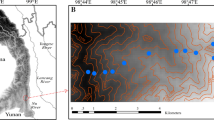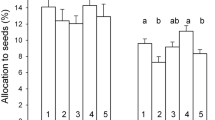Abstract
The present studies indicate that the differentiation of ecotypes inEuphorbia hirta into erect and prostrate forms as related to soil moisture and compaction is not complete and often they may be merely plastic modifications. Besides, the reproductive strategies of the two ecotypes and different in that the prostrate form has greater reproductive effort compared to vegetative growth. It was also shown that the two populations show differences in their abundance at different seasons of the year.
Similar content being viewed by others
References
Ramakrishnan, P. S.,J. Indian Bot. Soc. 39 455 (1960).
Turesson, G.,Hereditas 3 211 (1922).
Heslop-Harrison, J.,New Concepts in Flowering Plant Taxonomy (Heinemann, London) (1953).
Ramakrishnan, P. S.,J. Indian Bot. Soc. 50 A (Jubilee Vol.) p. 611 (1971).
Ramakrishnan, P. S.,Vistas in Plant Sciences eds: T. M. Varghese and R. K. Grover (1972).
Ramakrishnan, P. S. (Unpublished).
Solbrig, O. T.,Am. Sci. 59 686 (1971).
Mc Arthur, R. and Wilson, E. O.,The Theory of Island Biogeography (Princeton University Press) (1967).
Solbrig, O. T. and Simpson, B. B.,J. Ecol. 62 473 (1974).
Author information
Authors and Affiliations
Rights and permissions
About this article
Cite this article
Ramakrishnan, P.S., Kanta, C. Reproductive strategies within the speciesEuphorbia hirta L. related to soil moisture and compaction. Proc. Indian Acad. Sci. 84, 226–230 (1976). https://doi.org/10.1007/BF03045545
Received:
Issue Date:
DOI: https://doi.org/10.1007/BF03045545




